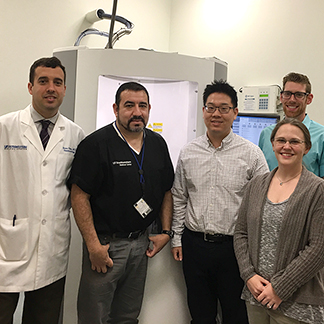2017 TIBIR Pilot Grants Awarded
In an effort to foster pioneering research into brain injury and repair at UT Southwestern, TIBIR awards pilot grants to support research studies that can generate novel insight about the cellular, systems, and functional mechanisms of damage and recovery. Applications for funding are solicited twice per year.
In Vivo Imaging of Traumatic Brain Injury Metabolism

Department:
Challenge
Traumatic brain injury (TBI) involves complex pathophysiological disease processes, causing mechanical and functional damages via primary and secondary injury mechanisms. A major challenge associated with treating TBI patients is the diverse secondary injury mechanisms that manifest after the primary injuries. Secondary injury includes complex metabolic and cellular evolvements occurring minutes to months after the primary injury, providing a potential window of opportunity for therapeutic intervention. This intervention may prevent or reduce secondary brain damage thereby improving long-term patient outcome. While multiple pathological alternations in TBI are potential biomarkers, no current clinical imaging modalities are sufficiently sensitive to identify brain sub-regions with secondary injury.
Approach
Hyperpolarized MRS imaging (MRSI) methods, by which MR signal enhancements of more than 50,000-fold are achievable using carbon-13 (13C)-labeled substrates, provide new opportunities to noninvasively image both the injected substrate and downstream metabolic products, thereby enabling unprecedented in vivo assessments of critical metabolic pathways. 13C-pyruvate labeled in the C1 position ([1-13C]pyruvate) is a suitable substrate to investigate cellular energy metabolism because there is cellular uptake and oxidization in the mitochondria via the tricarboxylic acid (TCA) cycle. Pyruvate can be enzymatically reduced to lactate in glycolysis or converted to acetyl-CoA and CO2, detected in vivo as bicarbonate (H13CO3-), as it enters the mitochondria. While more technically challenging, pyruvate labeled in the C2 position ([2-13C]pyruvate) not only measures the conversion of pyruvate to lactate and alanine but also extends the traceable metabolic pathways to relevant mitochondrial functions such as fatty-acid metabolism, ketogenesis, and the TCA cycle. In this study, the altered glycolysis and mitochondrial dysfunction in TBI patients will be investigated using hyperpolarized [1-13C]pyruvate and [2-13C]pyruvate.
Overall Goals
The overall goal is to develop/evaluate MRSI of hyperpolarized 13C-labeled pyruvate as a powerful technique for identifying the complex cellular and molecular changes underlying in vivo brain metabolism in TBI patients.
Significance
The significance of this proposal is based on the pressing clinical need to identify tissue injury and the severity of TBI, and the high impact a noninvasive imaging test would have for improved diagnosis, optimized patient management, and accelerated drug development.

